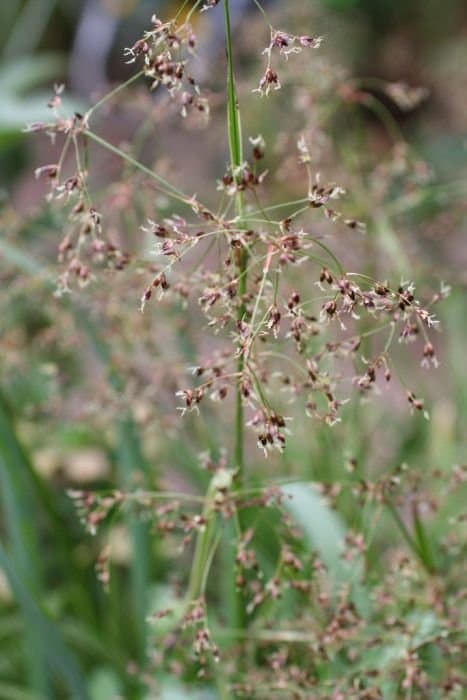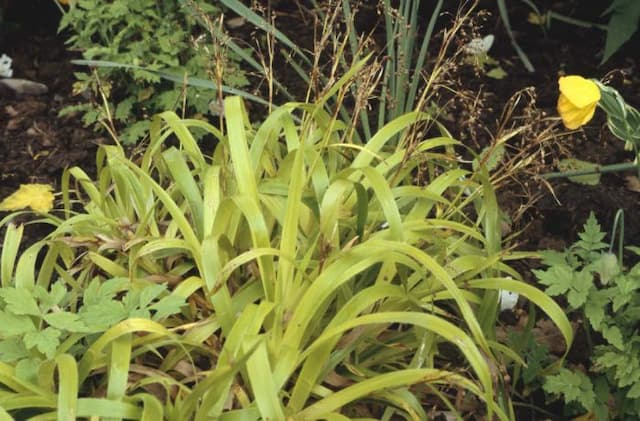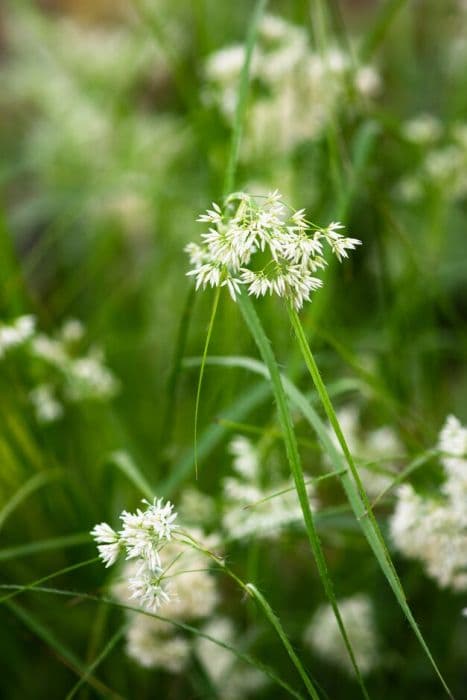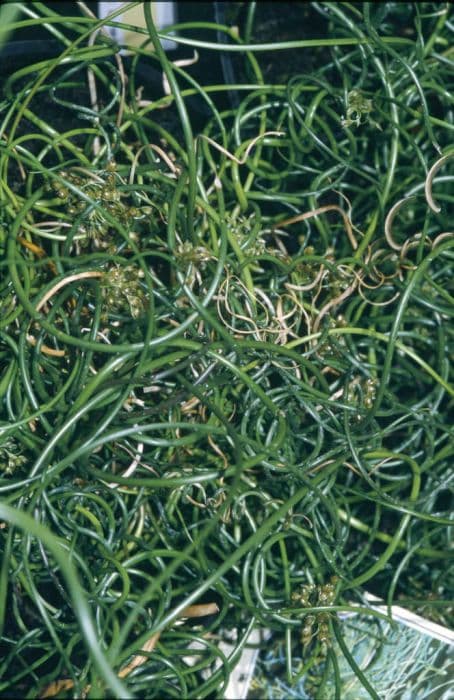Variegated Woodrush Luzula sylvatica 'Marginata' (v)

ABOUT
The plant in question, commonly known as 'Variegated Woodrush', is characterized by its striking foliage. The leaves are long and narrow, bearing a vibrant green color that is edged with a creamy white or yellowish margin. This variegation adds a splash of brightness to the plant's appearance, creating a stark contrast with the darker green center of the leaves. The texture of the leaves is often described as hairy or grass-like, which can add an interesting tactile element to a garden setting. This variety of Woodrush produces tufts of growth, giving it a somewhat shaggy or unkempt look, which can provide a naturalistic feel to landscapes. As the seasons change, this decidural plant may also exhibit different colors, adding to its ornamental value.
About this plant
 Names
NamesSynonyms
Variegated Wood Rush, Variegated Great Woodrush, Marginata Woodrush
Common names
Juncoides sylvaticum (Huds.) Kuntze, Juncus sylvaticus Huds., Luzula maxima var. marginata (Buchenau) Zabel, Luzula multiflora var. marginata Buchenau, Luzula multiflora var. sylvatica (Huds.) Čelak.
 Toxicity
ToxicityTo humans
Great wood-rush is not known to be toxic to humans. Consequently, there are no specific symptoms of poisoning associated with this plant, as it is generally considered safe and non-toxic. It does not usually pose any significant risk when touched or ingested in typical garden scenarios.
To pets
Great wood-rush is not known to be toxic to pets. It is not associated with any documented cases of poisoning in domestic animals like cats and dogs, and therefore there are no specific symptoms to be concerned about in relation to pet health when they come into contact with or ingest this plant.
 Characteristics
CharacteristicsLife cycle
Perennials
Foliage type
Evergreen
Color of leaves
Variegated
Flower color
Brown
Height
1-2 feet (30-60 cm)
Spread
1-2 feet (30-60 cm)
Plant type
Herb
Hardiness zones
5
Native area
Europe
Benefits
 General Benefits
General Benefits- Ornamental Value: Features variegated foliage that adds visual interest to shade gardens.
- Low Maintenance: Requires minimal care once established, ideal for busy gardeners.
- Shade Tolerance: Thrives in shady areas where other plants may struggle to grow.
- Soil Erosion Control: Its dense growth helps stabilize soil and prevent erosion in wooded areas.
- Drought Resistance: Once established, it can withstand periods of dry conditions.
- Habitat Support: Provides shelter and material for birds and small wildlife.
- Seasonal Interest: Offers year-round greenery and can add texture to the garden in all seasons.
- Companion Planting: Works well as an understory plant, complementing taller shade-loving shrubs and trees.
 Medical Properties
Medical PropertiesThis plant is not used for medical purposes.
 Air-purifying Qualities
Air-purifying QualitiesThis plant is not specifically known for air purifying qualities.
 Other Uses
Other Uses- Luzula sylvatica 'Marginata', also known as Variegated Woodrush, can be used in floral arrangements for a touch of greenery that adds texture and interest with its bright variegated leaves.
- In garden design, Variegated Woodrush can be employed as a contrasting plant to highlight brighter flowers or to provide a variegated backdrop for single-color themed gardens.
- The plant acts as a natural mulch, with its dense foliage helping to retain soil moisture and suppress weed growth, reducing the need for additional mulching materials.
- Variegated Woodrush can serve as an indicator plant, with changes in leaf color potentially signaling soil deficiencies or watering issues in garden settings.
- Its decorative seed heads can be sprayed with metallic or colored paint and used in creative crafts or as part of dried flower arrangements.
- When used in a sensory garden, the grass-like texture of Variegated Woodrush provides a tactile experience for visitors, especially those with visual impairments.
- As a companion plant, it can be helpful for highlighting the changing seasons in a garden with its evergreen nature being particularly valuable in the winter.
- The grass can be integrated into green roofing projects as part of a living roof system, providing insulation and habitat for wildlife.
- For photographers or artists, the plant's striking foliage can be used as a natural backdrop or focal point in outdoor portraiture and still-life photography.
- In a wildlife garden, Variegated Woodrush can provide cover for small animals and insects, contributing to biodiversity and ecological balance.
Interesting Facts
 Feng Shui
Feng ShuiThe Great Woodrush is not used in Feng Shui practice.
 Zodiac Sign Compitability
Zodiac Sign CompitabilityThe Great Woodrush is not used in astrology practice.
 Plant Symbolism
Plant Symbolism- Resilience: Luzula sylvatica 'Marginata', commonly known as the Variegated Woodrush, often thrives in shaded woodland areas, symbolizing the ability to grow and persevere in environments that are less than ideal.
- Adaptability: This plant's tolerance of various soil types and conditions represents adaptability and the capability to thrive in diverse situations.
- Humility: As a ground-covering plant, the Variegated Woodrush does not strive to reach the heights of trees but instead covers the earth humbly, often representing modesty and unassuming presence.
 Water
WaterThe Variegated Woodrush should be watered deeply but infrequently, allowing the soil to dry out slightly between waterings. Typically, this would mean providing about 1 to 2 gallons of water per week during the growing season, depending on the local climate and soil conditions. Reduction in the amount of water is necessary during the winter months when the plant is not actively growing. Ensure that the plant has proper drainage to prevent waterlogging, which could result in root rot.
 Light
LightVariegated Woodrush thrives best in partial shade to full shade conditions. It should be placed in a location where it can receive dappled sunlight or light shade throughout the day to avoid the harsh effects of direct sunlight, which can scorch its foliage.
 Temperature
TemperatureVariegated Woodrush prefers cool to moderate temperature conditions and can tolerate a temperature range from approximately 20°F to 70°F. The ideal growing temperatures are between 50°F and 65°F. This plant is cold hardy and can survive in temperatures down to about 20°F without significant damage.
 Pruning
PruningPruning Variegated Woodrush is mainly for aesthetic purposes to remove any brown or damaged leaves and to maintain a neat appearance. Pruning can be done in early spring before new growth starts or after the plant has finished flowering. Remove dead foliage by cutting at the base or gently pulling it out. Pruning once a year is usually sufficient.
 Cleaning
CleaningAs needed
 Soil
SoilThe best soil mix for Variegated woodrush should be rich, well-draining loam. It prefers soil with a slightly acidic to neutral pH between 5.5 and 7.
 Repotting
RepottingVariegated woodrush typically does not need frequent repotting; every 2-3 years is sufficient to refresh the soil and address root growth.
 Humidity & Misting
Humidity & MistingVariegated woodrush thrives best in moderate humidity but is quite adaptable and can tolerate lower humidity levels.
 Suitable locations
Suitable locationsIndoor
Place in bright, indirect light with moist, well-draining soil.
Outdoor
Partial shade and moist, well-drained soil is ideal for growth.
Hardiness zone
5-9 USDA
 Life cycle
Life cycleLuzula sylvatica 'Marginata', commonly known as Variegated Woodrush, begins its life cycle as a seed, which germinates in a moist, shaded environment to produce a small seedling. The seedling develops into a clump-forming perennial plant with narrow, green leaves edged with creamy-white stripes. Through vegetative growth, it expands by producing rhizomes (underground stems) that sprout new shoots, gradually forming a dense mat. The plant reaches maturity within a few years, developing flower stalks that bear clusters of small, brown flowers in the spring. After pollination, these flowers produce seeds, which are then dispersed by wind, animals, or water, continuing the reproductive cycle. As a perennial, Variegated Woodrush dies back to the ground level during winter and re-sprouts from the rhizome in the spring, continuing its lifecycle for many years.
 Propogation
PropogationPropogation time
Spring to early summer
Luzula sylvatica 'Marginata', also known as variegated woodrush, is most commonly propagated through division. The best time to divide this plant is in the spring or early fall when the plant is not in active growth. To propagate by division, carefully dig up the clump of woodrush and gently separate the plant into smaller sections, each with a portion of the root system. These divisions can then be replanted in a suitable location, spaced about 12 inches (approximately 30 centimeters) apart, ensuring that they are planted at the same depth as they were growing previously. Water the new divisions well to help establish them. This method is simple and effective, allowing gardeners to quickly increase their stock of variegated woodrush while maintaining the variegated characteristics of the parent plant.




